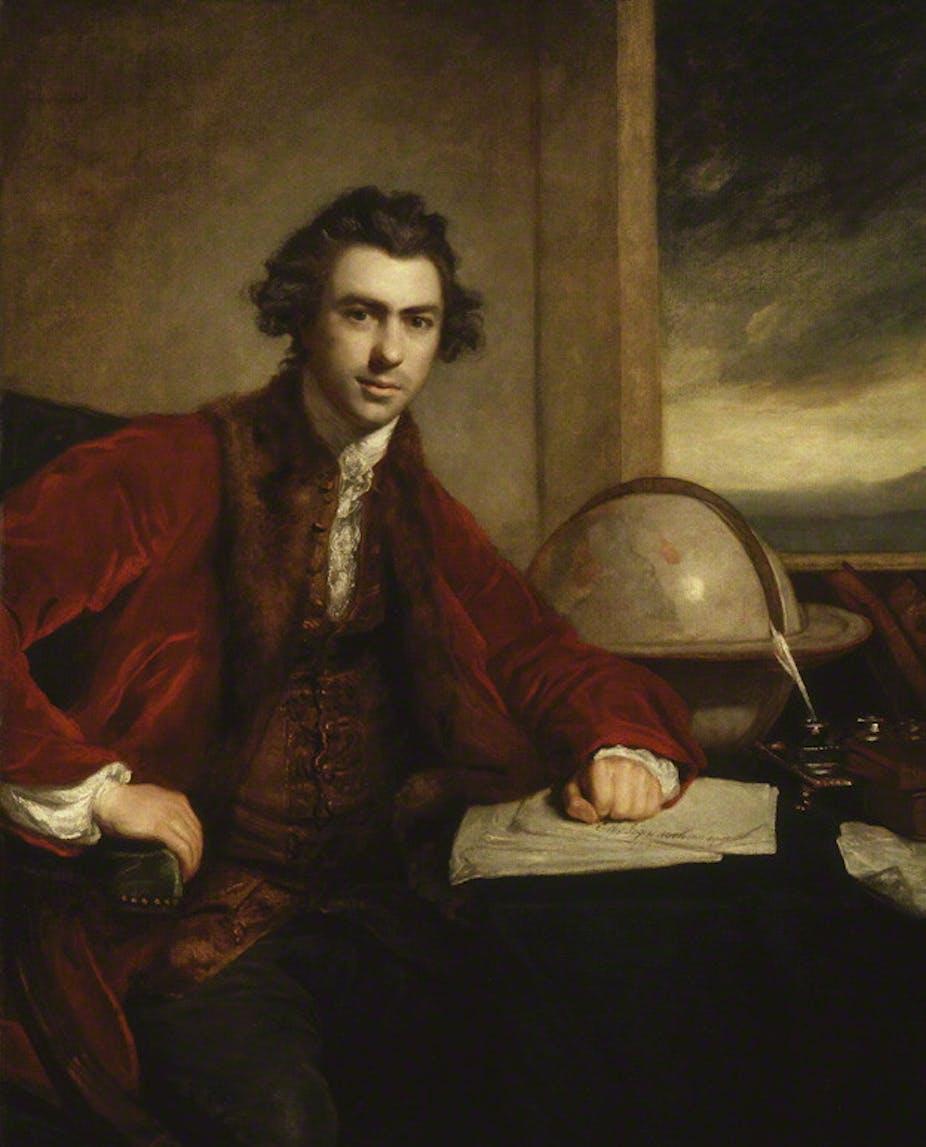Captain James Cook arrived in the Pacific 250 years ago, triggering British colonisation of the region. We’re asking researchers to reflect on what happened and how it shapes us today. You can see other stories in the series here and an interactive here.
Sir Joseph Banks is justly celebrated as a “naturalist, botanist, and patron of the natural sciences.” His role as an expedition scientist on Captain Cook’s first voyage set a benchmark for rigour, and helped to lift him to election as president of the Royal Society in 1778. From that position, he directed and encouraged multinational scientific endeavours for more than four decades. Less well-known is how he used that science to pursue imperial power.
The role of science in the “Age of Enlightenment” has sometimes been imagined as a bubble of purity, where the hunt for new knowledge outweighed all other considerations. It is certainly true that warring European powers granted safe passage for elite scientific correspondence, and sometimes for individual scholars, or whole expeditions. But the context for this was a consensus on the value of scientific discovery for the pursuit of imperial aggrandisement.
Banks was a hereditary member of the English establishment. Born in 1743, his father and grandfather had been members of parliament and he inherited extensive Lincolnshire estates at an early age. He blended formal education with self-funded studies, and by his mid-20s, was already a member of the Royal Society, undertaking an expedition to the north-eastern shores of Canada, where he identified the Great Auk for science.
Great Southern Continent
Cook’s first voyage was ostensibly to observe the “transit of Venus” across the face of the sun in 1769: thus forming part of a multinational scientific effort to map the size of the solar system. But a deeper goal had already been voiced.
The first person the Royal Society suggested to command the voyage was Alexander Dalrymple, an eminent Scottish geographer and vocal proponent of the theory that a “Great Southern Continent” awaited discovery. He saw this as an opportunity equivalent to the discovery of the Americas, so great, as he wrote in his 1770/71 volume An Historical collection of the several voyages and discoveries in the South Pacific Ocean, that even:
the scraps from this table would be sufficient to maintain the power, dominion, and sovereignty of Britain.
Dalrymple, however, demanded a full naval captain’s commission, which the Admiralty would not grant to a man who was not a professional seaman. James Cook had the necessary background, and was content with lieutenant’s rank. Cook’s voyage, of course, disproved the theory of a great Terra Australis, while at the same time mapping the outlines of New Zealand and eastern Australia. Banks (who had paid out of his own pocket for eight other scientists and servants to accompany him) both diligently completed his core botanical duties, and returned with clear views on how British imperial power could be enhanced through Cook’s discoveries.
Banks firmly advocated the strategic use of colonisation, vigorously promoting the use of “Botany Bay” as a penal colony. He sought to have interloping American trading vessels excluded from New South Wales “with severity”, but was not averse to other nations setting up settlements elsewhere in Australia, because there was a “moral certainty” that such territories would fall “into our hands in time of war”.
The Bounty
Banks was also the guiding light behind the most notorious episode of attempted ecological imperialism in the 1780s: the voyage of the Bounty, which set sail from the south coast of England in 1787, bound for what its crew saw as the very furthest reaches of the world. Banks had personally overseen its refitting, including the transformation of its captain’s cabin into a greenhouse, where hundreds of breadfruit seedlings were to be nurtured.

The ship’s captain, William Bligh – who was only 35, not the grizzled veteran sometimes depicted – had been sailing-master on Cook’s fatal third voyage, and had come under Banks’ subsequent patronage. His mission failed dramatically, not least because of the huge pressure its goals put him under, and the Bounty was lost to Fletcher Christian and his fellow mutineers in April 1789. Bligh redeemed his naval reputation with a voyage of more than 3,600 nautical miles to safety in an open boat. Only two years later, he led a second voyage of two ships, which did bring breadfruit from Tahiti all the way to the Caribbean. The Royal Society awarded him a gold medal.
Breadfruit never became a self-sustaining food crop for Britain’s brutalised plantation slaves, which had been the grim objective at the heart of these voyages. But this was just one small part of Banks’ vision of imperial botany. He took a leading role in establishing the Royal Botanical Gardens at Kew as a centre for the systematic study of the world’s plants. He helped promote a network of such centres, from Calcutta to St Vincent in the Caribbean, and the exchange of species between them.
In the lead-up to Bligh’s departure, Banks had expounded in a letter on the benefits of transplantation. From his own previous voyages, he noted the potential value of New Zealand flax for rope-making, and the “Mangosteens, Jacks, Durians” that might be brought westwards from Malaya (now Malaysia). One letter listed more than 30 products of both hemispheres that might be profitably transplanted, from the “lichee” to Basmati rice, “Naugharbussee bamboo” – superior, he noted, to Philippine bamboos already brought to the Caribbean by the Spanish – and what he called the “Cajir Gautch”, a palm whose sap made an alcoholic drink.
Banks closed this letter by noting how happy and eager he was to take forward such plans “so highly fraught with disinterested benevolence” as they were. His correspondent, however, was His Majesty’s secretary for war Sir George Yonge. Sir Joseph Banks, like so many leading lights of his generation, drew no distinction between the advancement of humanity and the interests of the British Empire.


